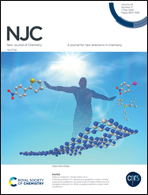A new integrated method of magnetic separation of isoquinoline alkaloids from Coptis chinensis based on their magnetized derivatives and key physical properties†
Abstract
For the first time, a new magnetic separation strategy for alkaloids from Coptis chinensis was developed in this study. For basic research, physical properties including thermal properties, solubility and magnetic properties of six Fe-containing magnetic compounds based on isoquinoline alkaloids (including isoquinoline, berberine, palmatine, tetrahydropalmatine, tetrahydropapaverine and berbamine) were characterized firstly, which showed good thermal stability (Tstart > 190 °C) and expected magnetic susceptibility (>1.35 × 10−5 emu g−1). The Gouy method measurement results were in agreement with the order determined using a vibrating sample magnetometer. Then the new integrated method of extraction–derivatization–magnetic separation was successfully applied for the target isoquinoline compounds from Coptis chinensis for the first time on the basis of the above studies, and the recovery of various samples was in the range of 96.85–101.4%. As the key operation in the whole process, derivatization/magnetization not only makes these alkaloids exhibit a good magnetic response in various states but also provides a new strategy of magnetic separation after their extraction. As a result, the effects of different extraction and derivatization conditions were investigated for target compounds from Coptis chinensis in detail.



 Please wait while we load your content...
Please wait while we load your content...